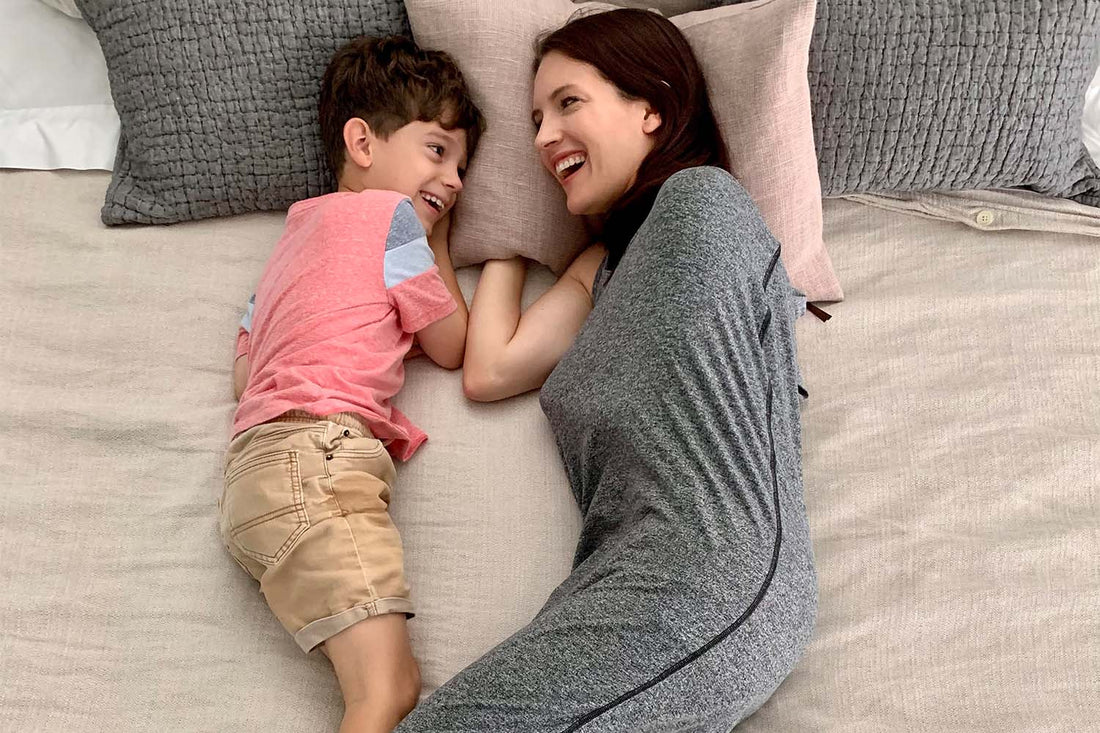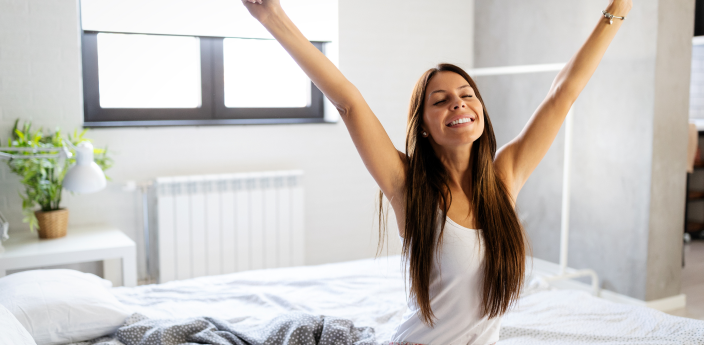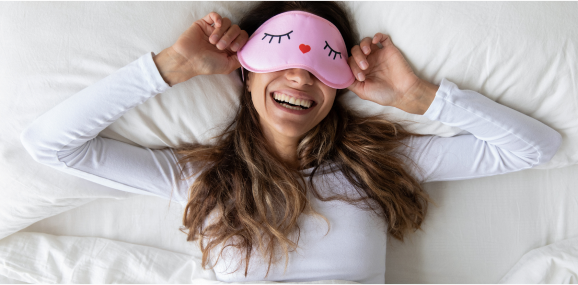Tossing and turning in bed not only robs you of sleep but also causes you to wake up sleepy and, probably, a little irritated. If you’ve been having trouble getting comfy when you hit the sack, you’re likely looking for ways to fix the problem.
The team at Hug Sleep is here to help. We like to think of ourselves as relaxation experts. As such, we’ve got ten great tips to help you unwind, get ready for bed, and settle into the coziest environment possible.
Together, we’ll talk about what causes comfort problems in bed, how to practice better sleep hygiene, and how one amazing blanket can help you relax into a better night.
What Causes Discomfort in Bed?
Of all the places you should feel most comfortable, your bed ranks high on the list. When you can’t get comfortable in bed night after night, it can trigger feelings of worry or nervousness — which can then make it even more challenging for you to get to sleep.
Here are some of the most common reasons you can’t get comfortable in bed.
Pain
Whether they have injuries or medical conditions that make it uncomfortable for them to lie in a prone position, people often cite pain as one of the main reasons they can’t get comfortable before sleeping.
Back pain especially is a common complaint for many sleepers. Proper spinal alignment is crucial to keeping your spine supported and ensuring you wake up pain-free. Sleeping on your back or stomach can worsen back pain and make it hard for you to get the rest you need.
Temperature
A major complaint during the summer months, the temperature of your bedroom can make it impossible to settle down comfortably in your bed.
The body’s core temperature naturally drops just before bed, but if your room is too cold, your body may start working double-time to heat your core temperature back up.
On the other hand, a room that is too hot can cause you to experience more periods of wakefulness. That makes it tough for your body to naturally transition to the deep sleep cycles you need to wake up feeling refreshed.
Sleep Disorders
Many people have sleep issues, but sleep disorders are something for which you’ll need to seek medical advice. Certain medical conditions, like sleep apnea, can make it markedly harder for you to get the sleep you need.
Talking to your healthcare provider about your sleep issues can help you determine if you need sleep medicine or if simple relaxation techniques can help you sleep better.
The Effects of Not Sleeping Comfortably
Missing sleep is no good for anyone. If discomfort has you up all night, you can expect to feel pretty miserable the next day. Here are a few of the specific effects you might encounter.
Tiredness
Hitting the snooze button because you simply can’t wake up is common for people who find it hard to get to sleep. You may also find yourself relying more heavily on stimulants like caffeine.
Naps
You might make it through your morning with enough coffee, but by midday, your body will be craving a nap. While some napping can be great for your body, it’s usually only if the nap lasts less than 30 minutes.
Napping for longer than half an hour can negatively impact the quality of sleep you get at bedtime, causing you to wake up more in the middle of the night.
After a few nights of sleeplessness, you’ll likely wake up feeling tired of being tired. When that happens, give one (or some) of these ten tips a try.
10 Tricks To Get Comfortable in Bed
Sleeping is a science, but preparing for sleep and how you go about it (referred to as sleep hygiene) is important. Here are 10 ways you can improve your sleep hygiene, find the perfect way to snuggle in, and finally get some great rest.
1. Set the Mood
Your sleep environment matters. It’s virtually impossible for anyone to fall asleep in a room that is hot, bright, cluttered, or stuffy. Before bed, do a “final sweep” to ensure your room is suitable for sleep by pulling the shades, picking up clutter, and turning down background noise.
2. Switch Positions
We all have our favorite sleeping position, but if yours isn’t helping you stay comfortable through the night, it might be time for a change. Switching your sleeping position can help alleviate lower back pain and help you get a good night’s sleep.
Curious what the best sleep position is? According to sleep experts at the Mayo Clinic, sleeping on your side in a slightly relaxed fetal position with a pillow between your legs helps support your spine and keep you comfortable.
3. Turn the Temperature Down
Your bedroom should be like a cave: cool, dark, and quiet. The National Sleep Foundation recommends turning the thermostat down between 60 to 67 degrees Fahrenheit to make sure you sleep well. The ideal sleeping temperature? About 65 degrees.
If that’s too cool for you, try adding a blanket or using a fan to create a little more airflow in your room.
4. Upgrade Your Bedding
Mattresses older than ten years need replacing, and many mid-grade mattresses will need to be cycled out even sooner.
If you aren’t sleeping, there’s no better time to get a new mattress. Although it may seem daunting, just remember that the right mattress will be firm, comfortable, and made from breathable material that won’t make you hot at night.
5. Try White Noise
Many sleepers find it impossible to sleep when it’s completely quiet. If you are bothered by the sound of your own (or your significant other’s) breathing, try some soft white noise. A ceiling fan or box fan both work perfectly and also help encourage airflow.
If you don’t want the extra breeze, there are numerous white noise apps that play everything from light rain to the sound of a hairdryer. Just make sure you have the screen turned off if you’re using a device. Otherwise, you’ll let in unnecessary light that could keep you awake.
6. Turn off the Electronic Devices
Some of us learn to fall asleep by watching old reruns on TV, but research shows that our televisions, smartphones, tablets, and laptops don’t help us fall asleep. In fact, avoiding your devices for at least half an hour before bedtime is the best way to ensure you're not disturbed by blue light.
Blue light is part of the visible light spectrum, and it’s emitted both from the sun and from devices like your phone and TV. Blue light can interfere with your circadian rhythm, the internal clock that tells your body when to be awake and when to be asleep.
Exposing your eyes to blue light can therefore throw off your sleep schedule. So, even though it might seem like scrolling your feed or watching TV will help you relax, it will likely end up with trouble sleeping.
Also, make sure your devices are on silent mode to avoid sleep disturbances once you’re already asleep.
7. Try Evolving Your Sleep Habits
If your sleep is erratic, your sleep schedule could be part of the problem. It’s hard to wind down and get comfortable when your body doesn’t know when you’ll hit the sack. Having a dedicated bedtime and preparing your body for sleep can help you relax and settle into bed more comfortably.
To get started, begin heading to your room at a certain time each night. If you still feel anxious, try deep breathing techniques, meditation, or a good book to help you wind down.
8. Use a Body Pillow
Getting more comfortable might be as simple as adding a cushion between your legs or against your chest while you sleep. Body pillows can help give you spinal support — and they’re also perfect for pregnant people who have trouble getting comfortable laying down.
9. Let the Dogs Out
We love our furry friends dearly, but they don’t do us any favors when we sleep. If your pet helps soothe your feelings of worry or stress, try putting a pet bed right next to your bedside.
Having a pet in your bed can increase the temperature between the sheets and also cause numerous sleep disturbances. Not to mention, they tend to hog all the space!
10. Try a Wearable Blanket
We swaddle babies because the gentle pressure of a swaddling cloth keeps them calm and prepares them for sleep. That’s kind of how a wearable blanket works for adults, and there’s science indicating that it can help you relax, feel more comfortable, and ease you into a peaceful sleep.
How DTPT Works
Deep touch pressure therapy, or DTPT, is the science of applying gentle pressure to certain points on the body to help the body transfer from a state of feeling alert to a state of rest and relaxation.
This technique has been studied extensively in patients with autism, but it’s also a great way to help the average person who experiences occasional sleep problems relax and rest better.
Your Nervous System
Your nervous system is complex, but there are two main components that help regulate your wake and sleep schedules: the sympathetic nervous system (SNS) and the parasympathetic nervous system (PSNS).
- SNS. Your SNS controls your awake hours. It keeps you alert, on guard, and ready to go into action. It’s also responsible for triggering the release of cortisol, the stress hormone that keeps our bodies and minds on high alert.
- PSNS. The PSNS prepares your body for sleep. It triggers the release of feel-good sleep hormones like melatonin, serotonin, and dopamine.
When these systems work in perfect balance, your SNS powers down in the evening, letting your PSNS take the night shift. Sometimes, though, the SNS just doesn’t want to clock out. That leaves you feeling nervous and stressed while your body struggles to relax and get comfortable for sleep.
Luckily, DTPT is scientifically proven to help your body switch from the SNS to the PSNS. It works by stimulating your body with gentle pressure, which you can harness by using something as simple as a blanket.
The Sleep Pod
The Hug Sleep Sleep Pod is the product of innovative minds that wanted an alternative to heavy, weighted blankets. They looked for an option that allowed for mobility, felt great both alone and underneath bedding, and offered the perfect amount of sensory pressure.
The Sleep Pod was their result. The Sleep Pod offers you the ability to relax, move around, and get comfortable — all while gently embracing you in four-way breathable fabric. It makes for a sensory experience your body will begin to crave.
Comfort, the Sleep Pod Way
When it’s time to settle into bed, ditch the heavy weighted blankets and uncomfortable bedding and opt for the only blanket that lets you be your own spoon. With the Sleep Pod, you’ll have the support you need to relax and ease into a great night’s sleep.
Sources:
Sleeping Positions That Reduce Back Pain | Mayo Clinic
Sleep Tips | National Sleep Foundation
Why It's Time To Ditch the Phone Before Bed | SCL Health
What Is Deep Pressure Stimulation? | AppliedBehaviorAnalysisEdu.org

































500,000+ happy customers